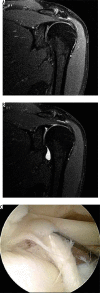Magnetic resonance-guided direct shoulder arthrography for the detection of superior labrum anterior-posterior lesions using an open 1.0-T MRI scanner
- PMID: 31481997
- PMCID: PMC6717947
- DOI: 10.5114/pjr.2019.86894
Magnetic resonance-guided direct shoulder arthrography for the detection of superior labrum anterior-posterior lesions using an open 1.0-T MRI scanner
Abstract
Purpose: Direct magnetic resonance arthrography (MRA) offers increased diagnostic accuracy compared to conventional magnetic resonance imaging (MRI) in the detection of superior labrum anterior-posterior (SLAP) lesions. The aim of the present study was to present the technique of magnetic resonance-guided direct shoulder arthrography (MDSA), to evaluate the diagnostic value of this novel MRA procedure to detect SLAP lesions in comparison to the currently practiced MRI, and to correlate the radiological findings to the respective arthroscopic findings.
Material and methods: Fifty-six patients with clinical signs of a SLAP lesion underwent both MRI examination and MDSA prior to arthroscopic surgery. The MRI of both interventions were compared with the arthroscopic findings. Statistical analysis was performed using the McNemar test.
Results: Sensitivity, specificity, and accuracy for detecting SLAP lesions were 23%, 88%, and 54% on MRI and 80%, 81%, and 80% on MDSA, respectively. Sensitivity (p < 0.001) and accuracy (p = 0.001) in detection of SLAP lesions were significantly higher by MDSA whereas accuracy showed no significant differences (p = 0.625).
Conclusions: The MDSA can be performed in an open 1.0-T MRI scanner with a high level of technical success and a reasonable methodical effort. The modification of MRA provides the requirements as a practicable routine shoulder magnetic resonance examination including arthrography to detect SLAP lesions. The diagnostic value is significantly better than MRI examinations without included arthrography, which currently predominates the clinical practice to investigate shoulder pathology.
Keywords: MR arthrography; SLAP lesions; conventional MRI; shoulder; shoulder arthroscopy.
Conflict of interest statement
The authors declare no conflict of interest.
Figures




References
-
- Mohana-Borges AV, Chung CB, Resnick D. Superior labral anteroposterior tear: classification and diagnosis on MRI and MR arthrography. AJR Am J Roentgenol. 2003;181:1449–1462. - PubMed
-
- Andrews JR, Carson WG, Jr, McLeod WD. Glenoid labrum tears related to the long head of the biceps. Am J Sports Med. 1985;13:337–341. - PubMed
-
- Snyder SJ, Karzel RP, Del PW, et al. SLAP lesions of the shoulder. Arthroscopy. 1990;6:274–279. - PubMed
-
- Handelberg F, Willems S, Shahabpour M, et al. SLAP lesions: a retrospective multicenter study. Arthroscopy. 1998;14:856–862. - PubMed
-
- Maffet MW, Gartsman GM, Moseley B. Superior labrum-biceps tendon complex lesions of the shoulder. Am J Sports Med. 1995;23:93–98. - PubMed
LinkOut - more resources
Full Text Sources
